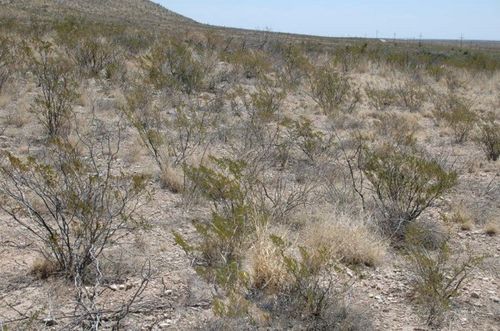
SWAP Habitat
Chihuahuan Desert Scrub
NVC Name
Chihuahuan Desert Scrub (M086)
SWAP General Vegetation Type
DESERT GRASSLAND and SCRUB
Chihuahuan Desert Scrub [M086] occurs mostly at 1,000-2,000 m (3,280-6,560 ft) elevation in the Chihuahuan Desert ecoregion. It may also be found in all other ecoregions except the Southern Rocky Mountains ecoregion. It is a moderate to sparse xeromorphic shrub community characterized by a sparse to dense tall shrub layer dominated or co-dominated by whitethorn acacia (Acacia constricta), viscid acacia (A. neovernicosa), tarbush, and creosote. Other species may include catclaw acacia (A. greggii), sand sagebrush (Artemisia filifolia), fourwing saltbush (Atriplex canescens), Torrey’s jointfir (Ephedra torreyana), longleaf jointfir (E. trifurca), ocotillo (Fouquieria splendens), cactus apple (Opuntia engelmannii), mariola (Parthenium incanum), soaptree yucca (Yucca elata), Torrey’s yucca (Y. torreyi), skeleton-leaf goldeneye (Viguiera stenoloba), and lechuguilla (Agave lechuguilla). Many stands of this habitat type lack an herbaceous understory layer and develop a pebbly desert pavement on the soil surface, sometimes with scattered grasses and forbs. If present, the understory is a sparse to moderately dense herbaceous layer dominated by grasses including black grama, bush muhly (Muhlenbergia porteri), curlyleaf muhly (M. setifolia), tobosagrass (Pleuraphis mutica), burrograss (Scleropogon brevifolius), and mesa dropseed (Sporobolus flexuosus). Forb species often are present, but have low cover.
Stands of this habitat occur in broad desert basins and plains and extend up onto dissected gravelly alluvial fans, piedmonts (bajadas), and foothills. Substrates include coarse-textured loams on well-drained, gravelly plains, slopes with soils that are typically non-saline and calcareous, sandy plains, coppice dunes, and sandsheets. Soils are fine-textured (silts, clay loams, and clays), often saline, on alluvial flats and around playas, as well as in river floodplains. Stands can extend upslope on to colluvial slopes with cobbly skeletal soils. Drought is a relatively common occurrence in this desert scrub, generally occurring every 10 to 15 years and lasting two to three years, with occasional long-term drought periods (10 to 15 years duration).
